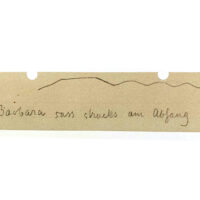A short essay on how ‹actually› became self-light.
«Actually, time for an afternoon nap, but playing in the sandbox together was so exciting for the children that today, they can play in the new sand together with the sandman instead.» Again and again in the days of my visit to the ‹Nyponkulla›, the rosehip hill, with Käty Toommägi and Holger Garthaus in Järna in the summer of 2020, I heard the word ‹actually›. It felt warm and flexible, even supple. When they asked me at the end of my Nyponkulla days to find a name for their kindergarten farm, the word ‹actually› was always on the tip of my tongue. It was washed up from my soul – where it had settled – again and again. After pondering for a long time, it gently transformed into ‹self-light›.
Self-light – acting as a pedagogical basic principle in such a way that every child and every adult can find and ignite his or her own light in a joint developmental game, at his or her own pace, and in his or her own way.
I do not experience any overly efficient thinking with Käty and Holger in the sense that: we must achieve this or that in a certain way by a specific time! The ‹actual› goal is to meet directly in the here and now in the joint actions of children and adults. The appropriate forms of work arise as if ‹by themselves›. When children and adults play in the sand together, creative chaos arises, which leads to the result as if by magic. Nyponkulla: a breathing swing on the rosehip hill, a place where children breathe, sleep, and play according to their nature, so my metaphor after pondering ‹actually›.
Hohenlohe ‹Actually›
«Actually, Fritz is right, but how are we supposed to change the conditions in this world? And I, as an individual, can’t do anything anyway.» One summer later I hear these ‹actually› sentences in many variations, on our ‹T amie h› BANKbank tour from Gammesfeld to Crailsheim. In the summer of 2019, the three of us founded the ‹ZukunftsWerk Fliegerhorst Crailsheim› with the intention of giving the former military quarter, in which mainly refugees and people on the margins of society – including many homeless people – live, impulses for a colorful, open, multicultural district. We gave our project the name ‹T amie h›, which in turn means home and includes in the middle of the word ‹amie›, French for friend. For us, ‹T amie h› symbolizes: finding a home – living community – shaping the future.1
For three days we move with our BANKbank on the specially made handcart through the villages of the Hohenlohe plain and present them to the people in their church and market squares. At the end of the tour in the Crailsheim on the Wall air base area, we inaugurate it together with its friend, the propeller sculpture by Paul Diestel. Made from the oak wood of his forest, we dedicate the first BANKbank to Friedrich Vogt, the village rebel, the last disciple of Raiffeisen, and the legendary head of the smallest bank in Germany. To this day, this is a one-man operation. The ‹hero› of the award-winning documentary about the Gammesfelder Raiffeisenbank, ‹Schotter wie Heu› (‹Gravel like Hay›), almost had star status during the times of the great financial crisis and was invited to all major talk shows.
Almost all Hohenlohe residents know and like ‹Fritz› when we talk to them. The Hohenlohe residents are rather taciturn and weigh the few words that come over their lips long and well. What comes out, has hand and foot. Like the bench on the wall in Crailsheim, which becomes the BANKbank every Friday from 2 to 6 pm. There you can meet people who have money and give it to those who need it privately or for the implementation of an idea, or lend it interest-free.
This Hohenlohe ‹actually› sounds different from the one from Nyponkulla. It expresses a perceived and lived powerlessness towards the capitalist financial and economic system and the resulting nature of our little fraternal Western life, destroying nature and our livelihoods. And it is a metaphor for the excuses and justifications for one’s own disingenuous thinking and acting, perceived as inconsistent and dishonest. We all know this supposed complaint: as individuals, we cannot do anything about the omnipotence of the system.
Access to Self-Light
I have to think of Friedrich Schiller and his ‹Letters on the Aesthetic Education of Human Beings›. My second Bible. Without the play with fabric and form, with sensuality and reason, with the ‹wild› and the ‹barbarian›, we find no access to our own light. If we seek this game of polarity and enhancement and play it seriously, then and only then do we become fully human. Because: «Human beings only play where they are human in the full meaning of the word, and they are only fully human where they play.» Goethe speaks of beauty that arises when we play with goodness and truth.
When we seek, find, and ignite our own light through our play, we feel light, warmth, and love. This is what we need inside and out, on a large and small scale, more than ever before in these times.
A consolation: ‹Miss Self-Light›, over whose ‹red thread› I stumble in the dark jungle of the Internet, calls out to me in one of her YouTube poetry films: «What would we be without what we are missing?»
Let’s go on the journey together and look for our own self-light. Where we find it and ignite it, there is ‹T amie h›.
Translation: Monika Werner





